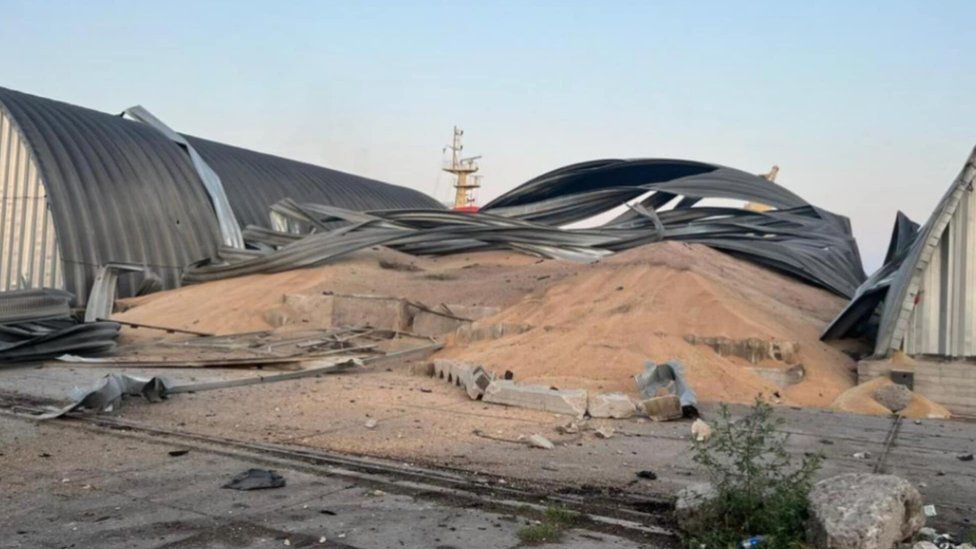Following the Kremlin’s refusal to renew the deal which allowed ships to transport grain across the Black Sea, Russia has started targeting Ukraine’s key alternative export routes along the Danube River.
We’ve looked at what grain infrastructure has been targeted and what this latest escalation means for global trade.
What has been hit?
Since it started in August 2022, almost 33 million tonnes of grain and other foodstuffs have been exported via the Black Sea grain deal.
But with Ukraine’s Black Sea ports now effectively blockaded by Russia, experts say it will have to rely heavily on its ports along the Danube river to export grain into neighbouring Romania.
From there it can be transported further afield as Romania’s ports remain open.
After repeatedly targeting export hubs on the Black Sea, Russia has now turned its missiles and drones on ports on the Danube.

One of Russia’s recent attacks hit the port of Reni, with missiles falling about 200m from the border with Nato-member Romania across the Danube.
In the Black Sea, the most extensive damage to port infrastructure was seen in Chornomorsk, where at least two storage tanks appear to have been hit on the night of 19 July.

Ukrainian authorities say that 60,000 tons of agricultural products were destroyed at the site.
The main grain terminal at Odesa port appears to have remained unscathed on satellite images we’ve analysed.
There have been several recent attacks on the city of Odesa, but these other strikes don’t seem to have disrupted grain trade.
Further south, in areas where Ukraine uses other export routes that bypass the Black Sea, the damage has been more extensive.
A total of 19 drone attacks on Danube ports were recorded on the night of 24 July, hitting Ukraine’s main alternative export routes, according to Lloyd’s List – a company that tracks global shipping markets.
Russia’s attack on Reni caused extensive damage.
From satellite imagery we can see the strikes have hit several silos, hangars and other buildings at the port.

The Zatoka bridge – a key link which allows grain trucks into the port of Izmail on the Danube – has also reportedly been hit.
How has this impacted exports?
“With the grain deal being over, the export of Ukrainian grain will stumble at maximum export capacity by river, trucks and rail to about 2.5 million tonnes per month,” says Mariia Bogonos, an agriculture policy expert at the Kyiv School of Economics.
The majority of this would travel via the Danube river.
“Prior to the war Odesa was the biggest grain exporter, but in recent months because of slow operations in Odesa, the Danube has become the main route,” says Andrey Sizov, an expert on the Black Sea agricultural markets.
Although the recent attacks temporarily closed the port of Reni, all the Danube ports appear to have swiftly returned to normal operations.
The strikes have failed to significantly affect trade along the river route, according to Lloyds List.
Any further disruption has an impact on the rest of Europe and the world – as global wheat prices will increase if there’s a hold up in trade.
Prices of wheat are up more than 10% since the deal enabling grain shipments to safely leave Black Sea ports collapsed.
Dozens of commercial ships are currently sailing in the Danube and waiting by the river’s mouth, according to vessel tracking data from Lloyd’s List.

There’s been speculation that this week’s strikes have caused a backlog, but Richard Meade, Editor-in-Chief of Lloyd’s List, says they’ve just exacerbated the congestion that’s been there since the start of the war.
“Without the [Black Sea grain deal], exports are heading to the south but there is a physical limitation on how many ships you can get through a narrow river corridor,” says Mr Meade.
Moscow and Kyiv have both threatened to treat some commercial vessels as military targets, which has added to tensions in the shipping industry.
Mr Meade believes it’s unlikely that either side will attack commercial ships, but even the threat of this will stop many boats from returning to the region – and those that do come back will face higher insurance premiums.
Lloyd’s List say the increased risk at Danube ports has left traders assessing the viability of remaining Ukraine grain export routes.
There are land routes where grain could be taken by truck or rail, but agriculture experts say this wouldn’t be quick or cheap to facilitate.
“The reason it’s taken in large quantities by boat is that its the lowest cost of transporting it, so all the other routes will add costs to the grain and the price will increase,” says Mike Lee, an agriculture expert who focuses on eastern Europe.
Mr Lee also says Russia could target those overland routes next.
“If they are hell-bent on stopping grain exports out of Ukraine then will they start to attack the rail infrastructure, they haven’t yet but the logical next step is the railways,” he says.
Additional reporting by Paul Brown, Joshua Cheetham, Filipa Silverio, Benedict Garman and Alex Murray.


Related Topics
- Russia-Ukraine war
- Russia
- Ukraine
